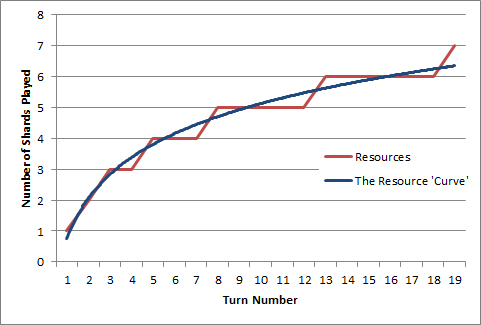No edit summary |
No edit summary |
||
| Line 1: | Line 1: | ||
| + | {{stub}} |
||
| + | |||
[[File:ResourceCurve.png|right]]Because you can only play one [[resource shard]] per turn (without the influence of card effects), there is a natural 'ramp-up' of card cost as the turns progress. That is, on turn one, you can usually only play cards with a cost of one, on turn two, you can play a card of cost two, or two of cost one, etc. |
[[File:ResourceCurve.png|right]]Because you can only play one [[resource shard]] per turn (without the influence of card effects), there is a natural 'ramp-up' of card cost as the turns progress. That is, on turn one, you can usually only play cards with a cost of one, on turn two, you can play a card of cost two, or two of cost one, etc. |
||
Revision as of 09:47, 12 August 2013
This article is a stub. You can help Hex Wiki by expanding it.
Because you can only play one resource shard per turn (without the influence of card effects), there is a natural 'ramp-up' of card cost as the turns progress. That is, on turn one, you can usually only play cards with a cost of one, on turn two, you can play a card of cost two, or two of cost one, etc.
In the initial draw, you can generally expect to hold a few resource shard cards, and so in the first few turns, each player can expect to be able to play a resource shard. Generally, this means that if you graph resources over time, the line initially starts out on the diagonal, and as players use up the resources from their deck, it plateaus - this distribution forms the 'curve' itself.
Building your deck so that you have cards of the correct costs at the correct time is an important component of deck building. Being able to draw and play cards that use all of your available resources and leaving a minimum of cards over is said to be playing 'on curve' or to 'curve out properly'.

